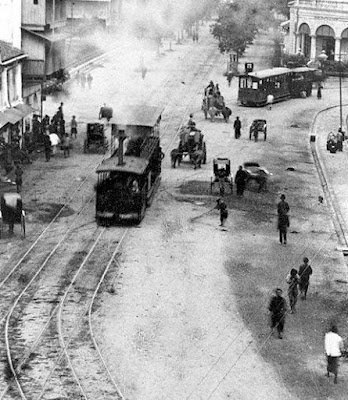 |
| A Map showing Singapore Electric Tramways' routes (c. 1905) (Source: 20th Century Impressions of British Malaya). |
The Tramways Ordinance of 1902 allowed the London-registered company, Singapore Tramways Limited, to set up a tramway system in Singapore. The first electric trams on the island began operations on 24 July 1905 under a new venture, Singapore Electric Tramways Limited, which acquired Singapore Tramways Limited. The board of directors sat in London, with Sir Frank A. Swettenham as its first chairman. The initial acquisitions and operations were handled by their Singapore agents, Messrs. Guthrie & Company Limited.
There were 50 single-deck passenger cars for its tram operations, which had three classes of travel. For the transport of freight, the company bought locomotives and freight wagons, and the types of cargo transported included animals, construction materials, agricultural produce, manufactured goods and wares and parcels. There were six tramway lines, which were based on the routes of the former 1886 steam tram service that was discontinued in 1894.
The routes covered Telok Blangah Road to Keppel Road, Tanjong Pagar Road to Geylang Road, Anson Road to Johnston’s Pier, Bras Basah Road to Serangoon Road, Serangoon Road to Kallang Road and High Street to Tank Road. The generating station situated in McKenzie Road, adjacent to the Rochor canal, from which an ample supply of water was obtained for condensing purposes. The building comprised of the power station and boiler house, car shed, workshop, as well as the company's general office. The power station also supplied electricity to the Municipal Commissioners of Singapore which in turn supplied electricity to private consumers.
A peculiar feature of the traffic is its denseness through China Town along North Bridge and South Bridge Roads. Almost two-thirds of the total number of passengers were carried on this section of the line, which extends for two miles. The tramway also ran into the less populated areas such as Geylang and Serangoon. This encouraged the ensuing development of both areas.
Tram rides were initially charged by the number of sections in a route or by the full distance of the route, with fares ranging from 10 to 20 cents. This was expensive in comparison to other existing modes of transportation such as rickshaws and horse carriages. Besides the limited tram routes covering areas away from town, high fares and the complicated payment structure added to the public’s reluctance to commute via tram. Fares were eventually reduced to as low as three cents per section. More people began to use the trams and in 1909 an average of 32,000 passengers a day used the trams.
However, trams faced a variety of issues such as obstructions on tramlines, vandalism, boycotts by Chinese guilds, as well as infrastructure and mechanical issues. In 1922, under advice from the Shanghai Electric Construction Company, tram operations were revamped, including repairs to the tramcars and revised fare scales in an effort to keep the system going. The situation improved and the operators were able to turn a profit.
Despite this turnaround, the municipality commissioners decided not to renew the tramway concessions. They cited incompatibility of the parties’ interests over the state of the roads on which the trams ran. It is said that the commissioners were embarrassed that the reconstructed tracks of the company ran on fine, metalled surface, while the outside lanes managed by the municipality were battered. The tram company was wound up and a new entity, the Singapore Traction Company, was formed in 1925 to operate electric-powered trolley buses introduced pursuant to the Singapore Traction Ordinance of 1925. The conversion from electric trams to trolley buses occurred in stages, with the last changeover happening at the end of 1927. The Singapore electric trolley bus system, dubbed as the world's largest, ceased operations in 1962.
Sources:
1. https://en.m.wikipedia.org/wiki/Trams_in_Singapore
2. https://eresources.nlb.gov.sg/infopedia/articles/SIP_1085_2006-06-08.html
3. https://eresources.nlb.gov.sg/history/events/9210d580-a90b-41f7-a50d-4b92df3eb83c
4. https://eresources.nlb.gov.sg/newspapers/Digitised/Article/easterndaily19060413-1.2.24.2
5. https://blogtoexpress.blogspot.com/2011/10/north-bridge-road-then-and-now.html
6. "Twentieth Century Impressions of British Malaya: Its History, People, Commerce, Industries, and Resources" Arnold Wright & H. A. Cartwright, Lloyd's Greater Britain Publishing Co. Ltd., 1908.
 |
| Steam Trams at Tanjong Pagar (c. 1892)(Source: National Library Board, Singapore) |
 |
| Tramcar (modern design) (c. 1905). (Source: 20th Century Impressions of British Malaya). |
 |
| Singapore Electric Tramways Ltd's Power Station at McKenzie Rd. (c. 1905) (Source: 20th Century Impressions of British Malaya). |
However, trams faced a variety of issues such as obstructions on tramlines, vandalism, boycotts by Chinese guilds, as well as infrastructure and mechanical issues. In 1922, under advice from the Shanghai Electric Construction Company, tram operations were revamped, including repairs to the tramcars and revised fare scales in an effort to keep the system going. The situation improved and the operators were able to turn a profit.
1. https://en.m.wikipedia.org/wiki/Trams_in_Singapore
2. https://eresources.nlb.gov.sg/infopedia/articles/SIP_1085_2006-06-08.html
3. https://eresources.nlb.gov.sg/history/events/9210d580-a90b-41f7-a50d-4b92df3eb83c
4. https://eresources.nlb.gov.sg/newspapers/Digitised/Article/easterndaily19060413-1.2.24.2
5. https://blogtoexpress.blogspot.com/2011/10/north-bridge-road-then-and-now.html
6. "Twentieth Century Impressions of British Malaya: Its History, People, Commerce, Industries, and Resources" Arnold Wright & H. A. Cartwright, Lloyd's Greater Britain Publishing Co. Ltd., 1908.













.jpg)